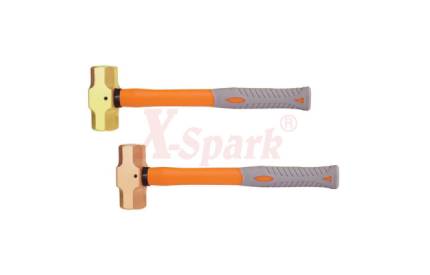In order to avoid the combustion and explosion of flammable substances around due to sparks caused by collision and friction, non-steel materials should be used for hand tools used in flammable and swellable places. If there are non-ferrous metals such as aluminum, magnesium, copper, etc., such hand tools made of non-steel materials used in flammable and coal-prone places are called explosion-proof tools, also known as non sparking tools or anti-sparking tools.
1. Development of explosion-proof tools
With the continuous development of industry, fire, and explosion accidents caused by tool sparks are becoming more and more prominent. Such disasters caused by tool sparks have occurred frequently at home and abroad. For example: On March 7, 1983, when a worker in a chemical plant in southwest China unleaded gasoline from an oil tank, an iron wrench opened the cap to generate a spark that caused an explosion, causing 7 deaths and 3 serious injuries; — Workers in chemical plants produced sparks when knocking the pump casing with a metal hammer during the pump operation of replacing the gas cooling tank, which caused an explosion of combustible gas in the tank. Four workers working on the tank lid were thrown 100m away and died on the spot. As a result, the issue of fire and explosion protection using tools is becoming more and more important.
2. The characteristics and safety of explosion proof tools
Aluminum and magnesium alloy tools, although it is not easy to produce sparks when impacted, aluminum and magnesium are lively, and the possibility of aluminothermic reaction and oxidation reaction is latent during use. The resulting chemical reaction heat will become a more dangerous ignition source. It is possible to ignite most flammable liquids or flammable gases in petrochemical enterprises. Therefore, it is quite dangerous to blindly use aluminum and magnesium tools in the petrochemical industry.
Due to the differences in the mechanical properties of copper and iron tools, the sparks generated during impact or friction contain different amounts of energy. Under the same impact energy, the impact or friction spark energy of copper tools is usually smaller than that of iron tools. The similar chemical properties of copper and iron metals make them exhibit similar characteristics, that is, no aluminothermic reaction occurs, and under certain conditions, they can oxidize in the air and release heat. The condition for the oxidation of copper and iron metals in the air is that they must be heated to a sufficiently high temperature. In the process of using the tool, there is no other heat source other than the impact or friction heat, and the impact or the heat is less, the copper and iron metal have good thermal conductivity, and the reaction cannot occur at a high enough temperature on the surface of the tool. Even if copper and iron metals undergo oxidation reactions, the reaction rate is low. Unlike the strong combustion reaction, the reaction heat emitted is small, and high-temperature glowing particles cannot be generated. The fire hazard lies in impact or friction sparks. Therefore, copper tools are more secure than iron tools.
According to relevant information, the safety sequence of aluminum, magnesium, steel, and iron tools is copper ≥ iron> lead> magnesium.

Explosion Proof Tools